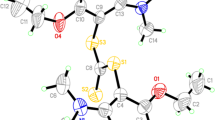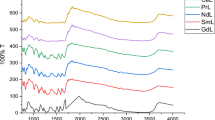Abstract
Today, cancer and resistant microbes remain one of the most deadly diseases in the world. In search of novel anti-cancer and anti-microbial probes, a series of newly hybrid molecules is synthesized by combining the structural features of aromatic amines and barbituric acid, using the concept of green chemistry. This approach was accomplished efficiently using water as the greener solvent and in the absence of catalyst to give the corresponding adducts. All newly synthesized compounds were characterized by spectral analysis FT-IR, 1H NMR, 13C NMR, HMBC and Elemental Analysis. Evaluations of these probes over four human cancer cell lines (Breast adenocarcinoma cancer cell line MCF-7, Non-small cell lung cancer cell line NCI-H460, CNS cancer cell line SF-268 and fibroblast cancer cell line WI-38), anti-microbial activity against five bacterial strains (S. pyogenes MTCC 442 and S. aureus MTCC 96 as the gram positive, E. coli MTCC 443, P. aeruginosa MTCC 424 and K. pneumoniae MTCC 109 as the gram negative) and four fungal strains (C. albicans MTCC 227, A. clavatus MTCC 1323, T. rubrum MTCC 296 and Penicillium wild strain). Out of set of nineteen probes, three probes show significant anti-cancer activities against MCF-7, NCI-H460 and SF-268, whereas sixteen probes exhibit potent anti-tumour activity against WI-38 cell lines. Within anti-microbial bioassay, three molecules exhibited significant activity against both the gram-positive as well as gram-negative bacteria, whereas two compounds showed highly potent activity against T. rubrum fungi, while three molecules were found to be equipotent against T. rubrum as a fungal strain.



Similar content being viewed by others
References
Boyd MR, Paull KD (1995) Some practical considerations and applications of the National Cancer Institute in vitro anticancer drug discovery screen. Drug Dev Res 34:91–109
Dhorajiya BD, Dholakiya BZ (2013) Green chemistry multi-component approach for N-formylation and Knoevenagel condensation for synthesis of thiobarbiturates in aqueous system. Res Chem Intermed. doi:10.1007/s11164-013-1190-4
Dhorajiya BD, Ibrahim AS, Badria FA, Dholakiya BZ (2014) Design and synthesis of novel nucleobasebased barbiturate derivatives as potential anticancer agents. Med Chem Res 23:839–847. doi:10.1007/s00044-013-0683-4
Gillespie SH (1994) Medical microbiology—illustrated. Butterworth Heinemann Ltd., United Kingdom, pp 234–247
Goodman LS, Gilman A (1991) In the pharmacological basis of therapeutics. Mc Graw-Hill, New Delhi, pp 358–360
Hawkey PM, Lewis DA (1994) Medical bacteriology—a practical approach. Oxford University Press, United Kingdom, pp 181–194
Huang LYM, Barker JL (1980) Pentobarbital stereospecific actions of (+) and (–) isomers revealed on cultured mammalian neurons. Science 207:195–197
Jacobson (1937) U. S. Patent 2,090, 594, [C. A. 31, 7068]
Jain S, Bhimireddy NR, Kolisetty SR (2011) l-Proline catalyzed Knoevenagel condensation: synthesis of some new indole derivatives and biological activities. Int J ChemTech Res 3:817–824
Kisfaludy L, Laszlo O (1987) Rapid and selective formylation with pentafluorophenyl formate. Synthesis 5:510
Meunier B (2008) Hybrid molecules with a dual mode of action: dream or reality? Acc Chem Res 41:69–77
Nerveux M, Bruneaum C, Dixneuf PH (1991) Enol formates: ruthenium catalysed formation and formylating reagents. J Chem Soc Perkin Trans 5:1197–1199
Nicoll RA, Wojtowicz JM (1980) The effects of pentobarbital and related compounds on frog motoneurons. Brain Res 191:225–237
Siddiqui ZN, Musthafa TN, Ahmad A, Khan AU (2011) Thermal solvent-free synthesis of novel pyrazolyl chalcones and pyrazolines as potential antimicrobial agents. Bioorg Med Chem Lett 15:2860–2865
Silverstein RM, Webster FX (1997) Spectrometric identification of organic compounds, 6th edn. Wiley, New York, pp 79–223
Singh P, Kaur M, Verma P (2009) Design, synthesis and anticancer activities of hybrids of indole and barbituric acids—identification of highly promising leads. Bioorg Med Chem Lett 19:3054–3058
Skehan P, Storeng R, Scudiero D, Monks A, McMahon J, Vistica D, Warren JT, Bokesch H, Kenney S, Boyd MR (1990) New colorimetric cytotoxicity assay for anticancer-drug screening. J Natl Cancer Inst 82:1107–1112
Sundberg RJ (1996) Indoles. Academic Press, San Diego
Acknowledgments
We are very much thankful to Gujarat Council on Science and Technology for financial support (Project No. Gujcost/MRP/202042/12-13/04) and Department of Applied Chemistry, SVNIT, Surat for providing laboratory facilities. We are also thankful to Mr. D. M. Thumar from Amoli Organic Pvt, Ltd, Baroda, Gujarat and Avtarsingh & Manishkumar from SAIF, Panjab University, Chandigarh, India for providing characterization facilities.
Conflict of interest
All three authors contributed equally to this work.
Author information
Authors and Affiliations
Corresponding authors
Electronic supplementary material
Below is the link to the electronic supplementary material.
Rights and permissions
About this article
Cite this article
Dhorajiya, B.D., Dholakiya, B.Z. & Mohareb, R.M. Hybrid probes of aromatic amine and barbituric acid: highly promising leads for anti-bacterial, anti-fungal and anti-cancer activities. Med Chem Res 23, 3941–3952 (2014). https://doi.org/10.1007/s00044-014-0973-5
Received:
Accepted:
Published:
Issue Date:
DOI: https://doi.org/10.1007/s00044-014-0973-5




